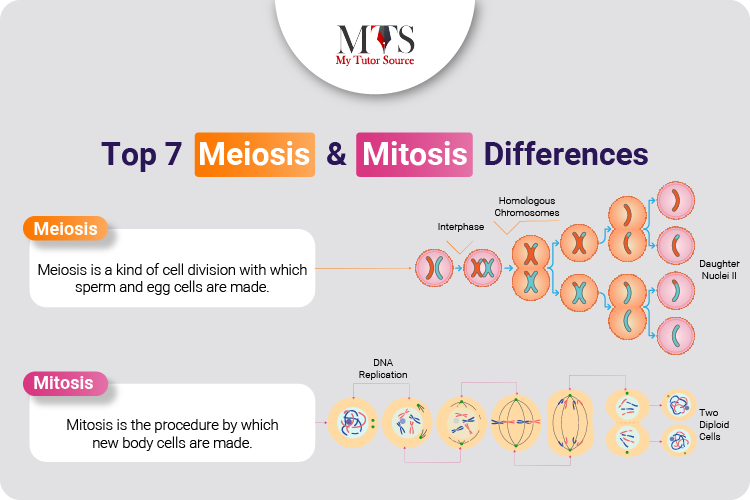

Meiosis and mitosis are the two important processes that are responsible for the continuity of life but did you know that both processes have some similarities and some distinct differences as well? Well, you are in luck because we have covered meiosis and mitosis differences and similarities in detail for you. So, keep reading for some interesting information:
Mitosis and meiosis are two major types of cell division. Normally, whenever someone talks about cell division, they are referring to mitosis. Mitosis is the procedure by which new body cells are made. On the contrary, Meiosis is a kind of cell division with which sperm and egg cells are made.
Cell division is the process that is responsible for the growth and reproduction of organisms. New cells in any eukaryotic cell are produced because of mitosis and meiosis, both of which are similar in some aspects but also different at the same time. Both mitosis and meiosis involve a diploid cell being divided, or a cell with two sets of chromosomes with each chromosome coming from each parent.
The DNA which is the genetic material duplicates and then gets divided equally between two cells in mitosis. The cell which gets divided undergoes a sequential series of steps which are collectively called the cell cycle. Mitosis starts with specific signals or growth factors that show that new cells need to be produced and then the somatic cells present in the body replicate. Somatic cells include skin cells, fat cells, blood cells, or any other kind of cells that are not sex cells. Mitosis is needed to replace damaged cells, cells with short life spans, or dead cells.
Meiosis, on the other hand, is involved in the generation of gametes in organisms that are capable of reproducing sexually. The gametes (sex cells) are created in female and male gonads and they have 50 percent of chromosomes. Thanks to genetic recombination, new combinations of genes get introduced in a population during meiosis. Thus, meiosis produces four cells, all of which are genetically different.
Let’s see how meiosis and mitosis differ from each other:
In mitosis, a somatic cell undergoes division only once and cytoplasm is divided when telophase ends (Cytokinesis).
In meiosis, a reproductive cell undergoes division twice and the cytoplasm is divided when telophase I and telophase II end.
In mitosis, there is a production of two daughter cells and both cells are diploid with equal chromosomes.
In meiosis, however, there is a production of four daughter cells, and each cell is haploid with one-half of chromosomes as compared to the original cell.
In mitosis, the daughter cells are clones of each other genetically and there is no crossing over or recombination.
In meiosis, the daughter cells are different from each other genetically because of the random segregation of homologous chromosomes that occurs because of crossing over.
In mitosis, the chromatin condenses into discrete chromosomes during the first stage called prophase. Cells normally spend less time in prophase in the case of mitosis as compared to the prophase I of meiosis which is quite longer than mitosis’s prophase.
In the case of meiosis, the very first stage is prophase I and it spans over 5 long stages which makes it longer than the prophase of mitosis. The meiotic prophase I consists of the following stages: leptotene, zygotene, pachytene, diplotene, and diakinesis and these do not happen in mitosis. Crossing over and genetic recombination happens during prophase I in meiosis.
There is no tetrad formation in mitotic cell division.
However, in meiosis, during prophase I, homologous chromosomes line up closely together in pairs to create a tetrad which has two sets of sister chromatids or four chromatids.
In mitosis the sister chromatids that are essentially just duplicated chromosomes made of two identical chromosomes attached to each other through the centromere region, align next to one another at the metaphase plate.
While in meiosis the homologous chromosome pairs, known as tetrads, align next to each other at the metaphase plate during metaphase I.
In mitosis, the sister chromatids separate from each other in anaphase and migrate towards the opposite opposites of the cell they are in. The separated chromatids are known as daughter chromosomes individually and as a full chromosome when together, respectively.
In meiosis, during anaphase I the homologous chromosomes migrate but do not separate during anaphase I.
There are both differences and similarities between mitosis and meiosis. Both are similar in some ways for example both are cell divisions and both involve a parent cell creating two identical daughter cells. Meiosis starts after one round of DNA replication in the cells of female or male sex organs. Meiosis is divided into two parts known as meiosis I and meiosis II, respectively. Meiosis I involves cell division that is unique only to germ cells. However, it is the second stage called meiosis II which is the same mitosis.
Now, that we have discussed the differences between the two types of cell divisions let’s see how both processes are similar to each other:
The meiosis and mitosis differences are quite easy to understand as both serve different purposes but the two are also quite similar to each other at the same time. While one (meiosis) is involved in genetic divisions, the other is more focused (mitosis) on the development and growth of cells. Moreover, meiosis is also very instrumental when it comes to the repairing of genetic defects in germline cells which is important for the continuity of life.